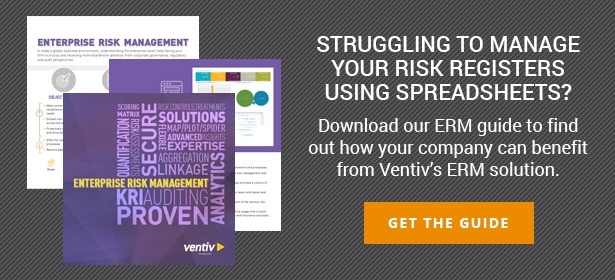In today’s global economy, it isn’t enough to prepare only for traditional business risks, such as fire or theft. Other, more complicated risks are becoming more prominent and expensive, particularly when it comes to failures of technology, gaps in cyber security and supply chain.
A growing number of insurance companies provide coverage against one or more of these new risks, but not everything can be insured — like a tarnished reputation.
More and more, organisations are turning to Enterprise Risk Management (ERM) to help them handle exposures in-house before they become a liability. ERM is a business strategy designed to help an organisation plan, prepare for and mitigate its business risks — the traditional risks and the newer ones, in an interconnected way.
But implementing a risk management framework can be challenging, too, especially when done with spreadsheets. With a huge amount of data to collect and manage and a growing number of stakeholders who need to weigh in, spreadsheets can actually add risk to your ERM system.
Simplify ERM with Technology
While spreadsheets do have their place and can be useful in the early maturity stages, to eliminate the chance for human error, establish uniformity and ensure data integrity and privacy in the ERM framework, something more than spreadsheets will be necessary. The answer is a dedicated risk management information system (RMIS).
A RMIS is an integrated information system that aggregates risk data in one place to help decision makers evaluate the intersection of all risk in a single view. It can be accessed from different locations and on different devices. It is flexible and agile, allowing for the changing needs of today’s workplace. Best of all, it can be tailored to support an organisation’s specific risk concerns, exposures, protection measures and risk management processes.
For example, a tailored RMIS can store information on loss-control measures, property values, records of prior claims and even relevant insurance policies. The system can also use the data to generate reports and even track insurance claims and related information to help stakeholders use the data effectively.
Other important benefits of adopting a dedicated RMIS to manage your risk include:
- Create one source of truth. With spreadsheets and other documents, there’s always a question of version control. Using a RMIS can be a game-changer. Targeted business planning by calculating risk is only possible with accurate data. Not only does technology remove the need for manually inputting data and subsequently introducing human error, but with all the information stored in one convenient location, you never have to search for a specific document or confirm you have the most up-to-date version. When it comes to managing risk, you have all the information you need in one place.
- Collaborate efficiently. Businesses will often have several departments taking separate actions to manage the same risk. It can be a challenge to eliminate the silos. With a RMIS, teams have no choice but to work together, accessing the same digital information and reports. Risk owners can be assigned, and all teams can coordinate efforts to mitigate the risk efficiently and improve overall business operations.
- Meet compliance and regulatory obligations. An audit is a stressful experience for any organisation. But with a RMIS to document and store all the necessary data, the audit moves more smoothly. Each entry in the RMIS is dated and documented, reducing the time and burden on administration. This also ensures each step has been dealt with appropriately and allows auditors and data protection officers to easily review processes.
- Improve your risk profile. With better and more accurate reporting tools, the latest data is available on demand, when you need it most. In addition, management can be better prepared to identify risks and act on opportunities to improve the organisation’s risk landscape. Taking these steps not only gives you more control over your business and increases employee productivity, but it also makes your organisation more attractive to an insurer when it comes time to secure protection against risk.
- Automate workflow. Following a risk management process is much more efficient when managers can easily sign off on tasks, and when data consolidation and reporting can be automated. Automation helps remove the need for mundane, manual tasks and frees up teams to spend their time on more meaningful work, such as improving risk management processes or focusing on other core business processes. When risk management is automated, the entire business benefits from the increased efficiency.
- Embed a culture of risk. A RMIS can help solidify and sustain a true culture of risk management across an organisation because it infiltrates the entire work environment. It enables a better ERM system to be built when everyone can work together toward the same goals. For example, risk managers can use information from the RMIS to share data and processes with staff members relating to specific risk management tasks, and staff can provide feedback directly in the RMIS framework itself. When everyone is on the same page when it comes to risk data and information, stakeholders across your organisation can better understand critical risks and the potential impact of those risks on the organisation’s bottom line.
Next Steps
Developing an ERM program can be daunting, but it doesn’t have to be. A RMIS may be just the solution to expand your ERM across the business, streamline processes and even adjust your risk scoring in order to better support the needs of the organisation.
For more information on RMIS technology and using it to support your ERM framework, contact David Thomas, Commercial Director.













